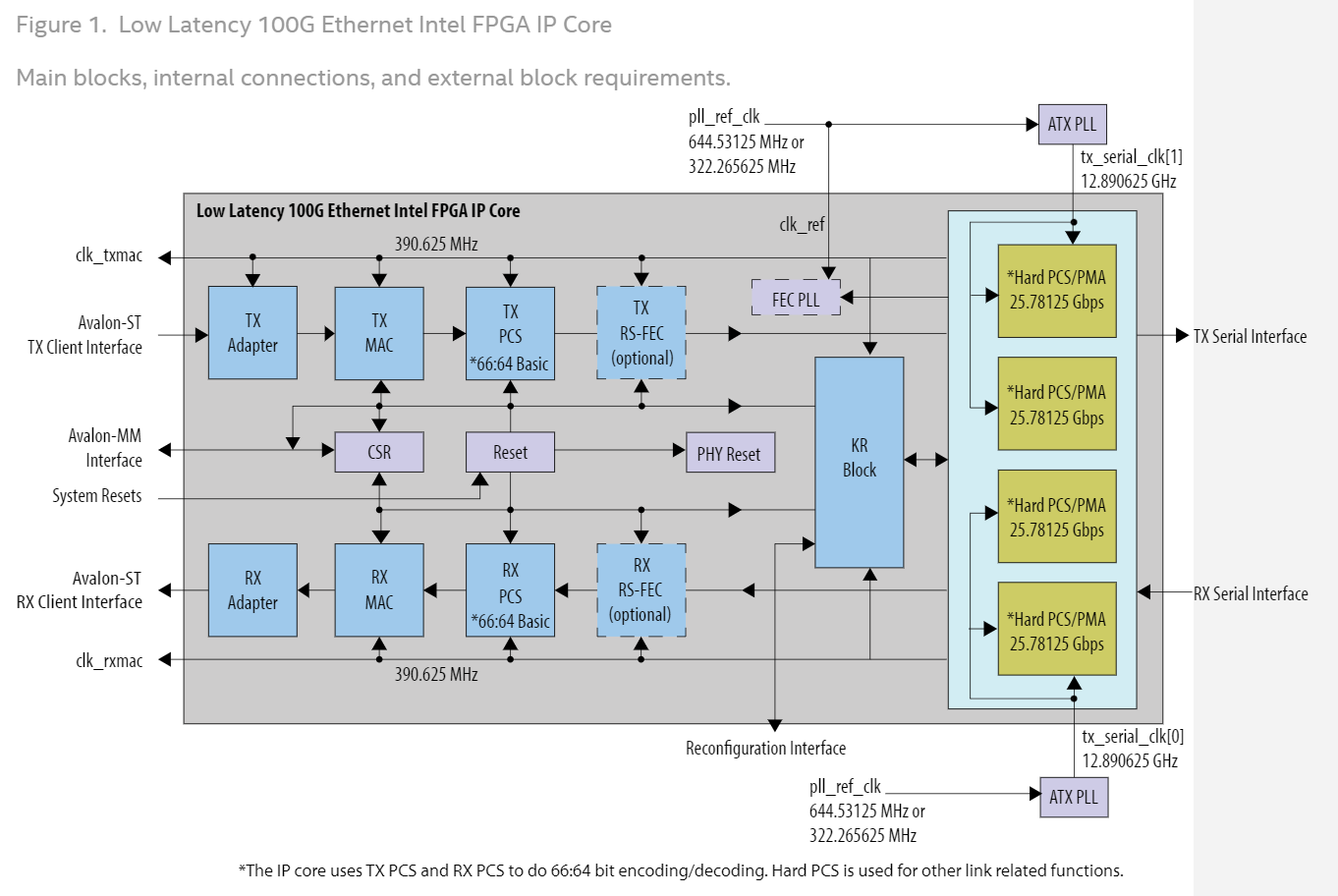Intel FPGA 100G VF(IFCVF) DPDK用户态VDPA设备probe探测流程
原创Intel FPGA 100G VF(IFCVF) DPDK用户态VDPA设备probe探测流程
原创
术语
IFCVF: Intel FPGA 100G VF
callfd: host侧IO处理完成后, 如果是split vring, 则将结果写入vring used字段, 然后写callfd通知qemu/guest
简介
IFCVF vDPA(虚拟主机数据路径加速)驱动程序为英特尔 FPGA 100G VF(IFCVF)提供支持。IFCVF 的数据路径与 virtio 环兼容,它充当 HW vhost 后端,可以通过 DMA 直接向/从 virtio 发送/接收数据包。此外,它还支持脏页记录和设备状态报告/恢复,此驱动程序启用其 vDPA 功能
不同的 VF 设备服务于位于不同 VM 中的不同 virtio 前端,因此每个 VF 都需要有自己的 DMA 地址转换服务。在驱动程序Probe探测期间,将创建一个新容器,使用此容器 vDPA 驱动程序可以使用 VM 的内存区域信息对 DMA 重映射表进行编程。实现的关键 vDPA 驱动程序操作:
- ifcvf_dev_config:使用 vhost lib 提供的 virtio 信息启用 VF 数据路径,包括 IOMMU 编程以启用 VF DMA 到 VM 的内存,VFIO 中断设置以将 HW 中断路由到 virtio 驱动程序,创建通知中继线程以将 virtio 驱动程序的kick(通知硬件)转换为 MMIO 写入 HW,HW 队列配置。当虚拟机中的 virtio 驱动程序准备就绪时,将调用此函数来设置硬件数据路径后端
- ifcvf_dev_close:撤销 ifcvf_dev_config 中的所有设置。实时迁移功能由 IFCVF 支持,此驱动程序启用此功能。对于脏页日志记录,VF 有助于记录数据包缓冲区写入,驱动程序有助于在设备停止时将使用的环设为脏的。由于 vDPA 驱动程序需要设置 MSI-X 向量来中断客户机,因此目前仅支持 vfio-pci, 当 virtio 驱动程序停止 VM 中的设备时,此函数会被调用
设备参数“sw-live-migration=1”将驱动程序配置为 SW 辅助实时迁移模式。在此模式下,驱动程序将在 LM 发生时设置 SW 中继线程,此线程将帮助设备记录脏页。因此,此模式不需要 HW 实现脏页记录功能块,但会根据网络吞吐量消耗一定比例的 CPU 资源。如果未指定此参数,驱动程序将依赖设备的记录功能。
使用 IFC VF 创建 vhost 端口
创建一个 vhost 套接字并通过 vhost API 为该套接字分配一个 VF 的设备 ID。当 QEMU vhost 连接准备就绪时,分配的 VF 将自动配置
特点
IFCVF 驱动程序的特点包括:
- 与 virtio 0.95 和 1.0 兼容。
- SW 协助 vDPA 实时迁移。
先决条件
具有 IOMMU 功能的平台。IFC VF 需要使用 VM 中的 virtio 驱动程序直接将地址转换服务转换为 Rx/Tx
依赖vfio-pci
vDPA 驱动程序需要设置 VF MSIX 中断,每个队列的中断向量都映射到与 virtio 环关联的 callfd。目前只有 vfio-pci 允许多个中断,因此 IFCVF 驱动程序依赖于 vfio-pci
使用 VIRTIO_NET_F_GUEST_ANNOUNCE 进行实时迁移
IFC VF 不支持 RARP 数据包生成,支持 VIRTIO_NET_F_GUEST_ANNOUNCE 功能的 virtio 前端可以帮助实现这一点
Intel 低延迟100G以太FPGA IP核架构

DPDK驱动源码流程
intel, vdpa, ifcvf_vdpa.c -> net/ifcvf:添加 ifcvf vDPA 驱动程序,IFCVF vDPA(vhost 数据路径加速)驱动程序为 Intel FPGA 100G VF(IFCVF)提供支持。IFCVF 的数据路径与 virtio 环兼容,它作为 HW vhost 后端工作,可以通过 DMA 直接向/从 virtio 发送/接收数据包。不同的 VF 设备服务于位于不同 VM 中的不同 virtio 前端,因此每个 VF 都需要有自己的 DMA 地址转换服务。在驱动程序探测期间,将创建一个新容器,使用此容器 vDPA 驱动程序可以使用 VM 的内存区域信息对 DMA 重映射表进行编程。实现的关键 vDPA 驱动程序操作:- ifcvf_dev_config:使用 vhost lib 提供的 virtio 信息启用 VF 数据路径,包括 IOMMU 编程以启用 VF DMA 到 VM 的内存,VFIO 中断设置以将 HW 中断路由到 virtio 驱动程序,创建通知中继线程以将 virtio 驱动程序的踢动转换为 MMIO 写入 HW,HW 队列配置。- ifcvf_dev_close:撤销 ifcvf_dev_config 中的所有设置。实时迁移功能由 IFCVF 支持,此驱动程序启用此功能。对于脏页日志记录,VF 有助于记录数据包缓冲区写入,驱动程序有助于在设备停止时将使用的环设为脏的。由于 vDPA 驱动程序需要设置 MSI-X 向量来中断客户机,因此目前仅支持 vfio-pci
RTE_PMD_REGISTER_PCI(net_ifcvf, rte_ifcvf_vdpa)
static struct rte_pci_driver rte_ifcvf_vdpa = {
.id_table = pci_id_ifcvf_map,
.drv_flags = 0,
.probe = ifcvf_pci_probe,
.remove = ifcvf_pci_remove,
};
// probe扫描硬件
ifcvf_pci_probe(struct rte_pci_driver *pci_drv __rte_unused, struct rte_pci_device *pci_dev)
kvlist = rte_kvargs_parse(pci_dev->device.devargs->args, ifcvf_valid_arguments)
rte_kvargs_count(kvlist, IFCVF_VDPA_MODE)
rte_kvargs_process(kvlist, IFCVF_VDPA_MODE, &open_int, &vdpa_mode)
list = rte_zmalloc("ifcvf", sizeof(*list), 0)
internal = rte_zmalloc("ifcvf", sizeof(*internal), 0)
internal->pdev = pci_dev
ifcvf_vfio_setup(internal)
rte_vfio_get_group_num(rte_pci_get_sysfs_path(), devname, &iommu_group_num)
internal->vfio_container_fd = rte_vfio_container_create()
internal->vfio_group_fd = rte_vfio_container_group_bind(internal->vfio_container_fd, iommu_group_num)
rte_pci_map_device(dev) -> map hw pcie bar to userspace
pci_vfio_map_resource
pci_vfio_map_resource_primary
pci_rte_vfio_setup_device
pci_vfio_setup_interrupts
vfio_enable_msi
internal->hw.mem_resource[i].addr = internal->pdev->mem_resource[i].addr;
internal->hw.mem_resource[i].phys_addr = internal->pdev->mem_resource[i].phys_addr;
internal->hw.mem_resource[i].len = internal->pdev->mem_resource[i].len;
ifcvf_init_hw(&internal->hw, internal->pdev)
ret = PCI_READ_CONFIG_BYTE(dev, &pos, PCI_CAPABILITY_LIST)
PCI_READ_CONFIG_RANGE(dev, (u32 *)&cap, sizeof(cap), pos)
rte_pci_read_config(dev, val, size, where)
case RTE_PCI_KDRV_IGB_UIO
case RTE_PCI_KDRV_UIO_GENERIC
pci_uio_read_config(intr_handle, buf, len, offset)
case RTE_PCI_KDRV_VFIO
pci_vfio_read_config(intr_handle, buf, len, offset)
int vfio_dev_fd = rte_intr_dev_fd_get(intr_handle)
pread64(vfio_dev_fd, buf, len, VFIO_GET_REGION_ADDR(VFIO_PCI_CONFIG_REGION_INDEX) + offs)
default
rte_pci_device_name(&device->addr, devname, RTE_DEV_NAME_MAX_LEN)
case IFCVF_PCI_CAP_COMMON_CFG
hw->common_cfg = get_cap_addr(hw, &cap)
hw->mem_resource[bar].addr + offset
case IFCVF_PCI_CAP_NOTIFY_CFG
hw->notify_base = get_cap_addr(hw, &cap)
case IFCVF_PCI_CAP_ISR_CFG
hw->isr = get_cap_addr(hw, &cap) -> 产生int#x中断, 如果设备不支持msi-x capability的话,在设备配置变化或者需要进行队列kick通知时,就需要用到isr capability
case IFCVF_PCI_CAP_DEVICE_CFG
hw->dev_cfg = get_cap_addr(hw, &cap)
hw->lm_cfg = hw->mem_resource[4].addr -> live migration
features = ifcvf_get_features(&internal->hw)
features_hi = IFCVF_READ_REG32(&cfg->device_feature) -> read features low and high
device_id = ifcvf_pci_get_device_type(pci_dev)
if (device_id == VIRTIO_ID_NET)
internal->max_queues = MIN(IFCVF_MAX_QUEUES, queue_pairs)
else if (device_id == VIRTIO_ID_BLOCK) -> when set device_id?
internal->hw.device_type = IFCVF_BLK
internal->max_queues = MIN(IFCVF_MAX_QUEUES, internal->hw.blk_cfg->num_queues)
DRV_LOG(DEBUG, "capacity : %"PRIu64"G", capacity >> 21)
DRV_LOG(DEBUG, "size_max : 0x%08x", internal->hw.blk_cfg->size_max);
DRV_LOG(DEBUG, "seg_max : 0x%08x", internal->hw.blk_cfg->seg_max);
DRV_LOG(DEBUG, "blk_size : 0x%08x", internal->hw.blk_cfg->blk_size);
DRV_LOG(DEBUG, " cylinders: %u", internal->hw.blk_cfg->geometry.cylinders);
DRV_LOG(DEBUG, " heads : %u", internal->hw.blk_cfg->geometry.heads);
DRV_LOG(DEBUG, " sectors : %u", internal->hw.blk_cfg->geometry.sectors);
DRV_LOG(DEBUG, "num_queues: 0x%08x",internal->hw.blk_cfg->num_queues);
if (rte_kvargs_count(kvlist, IFCVF_SW_FALLBACK_LM)) -> sw-live-migration
rte_kvargs_process(kvlist, IFCVF_SW_FALLBACK_LM, &open_int, &sw_fallback_lm)
TAILQ_INSERT_TAIL(&internal_list, list, next)
internal->vdev = rte_vdpa_register_device(&pci_dev->device, dev_info[internal->hw.device_type].ops) -> ifcvf_blk_ops | ifcvf_net_ops
dev = __vdpa_find_device_by_name(rte_dev->name)
dev = rte_zmalloc(NULL, sizeof(*dev), 0)
dev->ops = ops
ops->get_dev_type(dev, &dev->type)
TAILQ_INSERT_TAIL(&vdpa_device_list, dev, next)
update_datapath(internal)
ifcvf_dma_map(internal, true)
rte_vhost_get_mem_table(internal->vid, &mem)
rte_vfio_container_dma_map(vfio_container_fd, reg->host_user_addr, reg->guest_phys_addr, reg->size)
vdpa_enable_vfio_intr(internal, false) -> enable irq -> 启动中断
irq_set->index = VFIO_PCI_MSIX_IRQ_INDEX
fd_ptr = (int *)&irq_set->data -> arry -> __u8 data[]
fd_ptr[RTE_INTR_VEC_ZERO_OFFSET] = rte_intr_fd_get(internal->pdev->intr_handle)
return intr_handle->fd
fd_ptr[RTE_INTR_VEC_RXTX_OFFSET + i] = vring.callfd -> bind vfio irq to callfd
fd = eventfd(0, EFD_NONBLOCK | EFD_CLOEXEC)
internal->intr_fd[i] = fd
ret = ioctl(internal->vfio_dev_fd, VFIO_DEVICE_SET_IRQS, irq_set) -> then kernel trigger irq by -> eventfd_signal(trigger, 1) -> qemu handle irq by -> event_notifier_test_and_clear
vdpa_ifcvf_start(internal)
ifcvf_start_hw(&internal->hw)
ifcvf_hw_enable(hw)
IFCVF_WRITE_REG16(0, &cfg->msix_config)
ifcvf_enable_mq(hw)
IFCVF_WRITE_REG16(i, &cfg->queue_select);
IFCVF_WRITE_REG16(i + 1, &cfg->queue_msix_vector)
hw->notify_addr[i] = (void *)((u8 *)hw->notify_base + notify_off * hw->notify_off_multiplier)
IFCVF_WRITE_REG16(1, &cfg->queue_enable)
ifcvf_add_status(hw, IFCVF_CONFIG_STATUS_DRIVER_OK)
ifcvf_set_status(hw, status)
IFCVF_WRITE_REG8(status, &hw->common_cfg->device_status)
ifcvf_get_status(hw)
setup_notify_relay(internal)
rte_ctrl_thread_create(&internal->tid, name, NULL, notify_relay, (void *)internal)
epfd = epoll_create(IFCVF_MAX_QUEUES * 2)
rte_vhost_get_vhost_vring(internal->vid, qid, &vring)
epoll_ctl(epfd, EPOLL_CTL_ADD, vring.kickfd, &ev) -> when qemu kick vhost, wakup epoll
for (;;)
nfds = epoll_wait(epfd, events, q_num, -1)
ifcvf_notify_queue(hw, qid)
setup_intr_relay(internal)
rte_ctrl_thread_create(&internal->intr_tid, name, NULL, intr_relay, (void *)internal) -> 创建具有给定名称和属性的控制线程。新线程的亲和性基于调用 rte_eal_init() 时检索到的 CPU 亲和性,然后排除数据平面和服务 lcore。如果设置线程名称失败,则忽略错误并记录调试消息 -> vdpa/ifc:为配置空间添加中断处理,创建一个线程来轮询和中继配置空间更改中断。使用 VHOST_USER_SLAVE_CONFIG_CHANGE_MSG 通知 QEMU
csc_epfd = epoll_create(1)
ev.data.fd = rte_intr_fd_get(internal->pdev->intr_handle)
for (;;)
csc_val = epoll_wait(csc_epfd, &csc_event, 1, -1)
nbytes = read(csc_event.data.fd, &buf, 8)
virtio_interrupt_handler(internal)
rte_vhost_slave_config_change(vid, 1)
vhost_user_slave_config_change(dev, need_reply)
.request.slave = VHOST_USER_SLAVE_CONFIG_CHANGE_MSG -> change notifications -> kernel virtio_config_changed
send_vhost_slave_message(dev, &ctx)
process_slave_message_reply(dev, &ctx)
rte_kvargs_free(kvlist)网络和块操作函数
static struct rte_vdpa_dev_ops ifcvf_net_ops = {
.get_queue_num = ifcvf_get_queue_num,
.get_features = ifcvf_get_vdpa_features,
.get_protocol_features = ifcvf_get_protocol_features,
.dev_conf = ifcvf_dev_config,
update_datapath(internal)
rte_vhost_host_notifier_ctrl
.dev_close = ifcvf_dev_close,
.set_vring_state = ifcvf_set_vring_state,
hw->vring[vring].enable = enable
unset_notify_relay(internal)
vdpa_enable_vfio_intr(internal, false)
irq_set->index = VFIO_PCI_MSIX_IRQ_INDEX
fd_ptr = (int *)&irq_set->data -> arry -> __u8 data[]
fd_ptr[RTE_INTR_VEC_ZERO_OFFSET] = rte_intr_fd_get(internal->pdev->intr_handle)
return intr_handle->fd
fd_ptr[RTE_INTR_VEC_RXTX_OFFSET + i] = vring.callfd -> bind vfio irq to callfd
fd = eventfd(0, EFD_NONBLOCK | EFD_CLOEXEC)
internal->intr_fd[i] = fd
ret = ioctl(internal->vfio_dev_fd, VFIO_DEVICE_SET_IRQS, irq_set) -> then kernel trigger irq by -> eventfd_signal(trigger, 1) -> qemu handle irq by -> event_notifier_test_and_clear
ifcvf_config_vring(internal, vring)
if (hw->vring[vring].enable)
rte_vhost_get_vhost_vring(vid, vring, &vq)
gpa = hva_to_gpa(vid, (uint64_t)(uintptr_t)vq.desc)
hw->vring[vring].desc = gpa
gpa = hva_to_gpa(vid, (uint64_t)(uintptr_t)vq.avail)
hw->vring[vring].avail = gpa
gpa = hva_to_gpa(vid, (uint64_t)(uintptr_t)vq.used)
hw->vring[vring].used = gpa
rte_vhost_get_vring_base(vid, vring, &hw->vring[vring].last_avail_idx, &hw->vring[vring].last_used_idx)
ifcvf_enable_vring_hw(&internal->hw, vring)
ifcvf_enable_mq(hw)
IFCVF_WRITE_REG16(i, &cfg->queue_select)
io_write64_twopart(hw->vring[i].desc, &cfg->queue_desc_lo, &cfg->queue_desc_hi)
hw->notify_addr[i] = (void *)((u8 *)hw->notify_base + notify_off * hw->notify_off_multiplier)
IFCVF_WRITE_REG16(1, &cfg->queue_enable)
setup_notify_relay(internal)
rte_vhost_host_notifier_ctrl(vid, vring, enable)
.set_features = ifcvf_set_features,
.migration_done = NULL,
.get_vfio_group_fd = ifcvf_get_vfio_group_fd,
.get_vfio_device_fd = ifcvf_get_vfio_device_fd,
.get_notify_area = ifcvf_get_notify_area,
.get_dev_type = ifcvf_get_device_type,
};
static struct rte_vdpa_dev_ops ifcvf_blk_ops = {
.get_queue_num = ifcvf_get_queue_num,
*queue_num = list->internal->max_queues
.get_features = ifcvf_get_vdpa_features,
*features = list->internal->features
.set_features = ifcvf_set_features,
if (internal->sw_lm) -> net/ifc:支持 SW 辅助 VDPA 实时迁移, 在 SW 辅助实时迁移模式下,驱动程序将停止设备并设置一个中介 virtio 环来中继 virtio 驱动程序和 VDPA 设备之间的通信。此数据路径干预将允许 SW 帮助客户机记录实时迁移的脏页。此 SW 回退是事件驱动的中继线程,因此当网络吞吐量较低时,此 SW 回退将占用很少的 CPU 资源,但当吞吐量上升时,中继线程的 CPU 使用率将相应上升。用户在选择实时迁移支持模式时需要考虑所有因素,包括 CPU 使用率、客户机性能下降等。
ifcvf_sw_fallback_switchover(internal)
stop the direct IO data path
unset_notify_relay
vdpa_ifcvf_stop
unset_intr_relay
vdpa_disable_vfio_intr
rte_vhost_host_notifier_ctrl(vid, RTE_VHOST_QUEUE_ALL, false) -> 内部函数
vfio_device_fd = vdpa_dev->ops->get_vfio_device_fd(vid)
if (enable)
vdpa_dev->ops->get_notify_area(vid, i, &offset, &size) < 0)
vhost_user_slave_set_vring_host_notifier(dev, i,vfio_device_fd, offset, size)
.request.slave = VHOST_USER_SLAVE_VRING_HOST_NOTIFIER_MSG
vdpa_enable_vfio_intr(internal, true)
config the VF
m_ifcvf_start
setup_vring_relay
rte_ctrl_thread_create(&internal->tid, name, NULL, vring_relay, (void *)internal)
epfd = epoll_create(IFCVF_MAX_QUEUES * 2)
epoll_ctl(epfd, EPOLL_CTL_ADD, vring.kickfd, &ev
nfds = epoll_wait(epfd, events, q_num * 2, -1)
update_used_ring(internal, qid)
rte_vhost_vring_call(internal->vid, qid) -> Notify the guest that used descriptors have been added to the vring. This function acts as a memory barrier.
for (;;)
nfds = epoll_wait(epfd, events, q_num * 2, -1)
nbytes = read(fd, &buf, 8)
qid = events[i].data.u32 >> 1
if (events[i].data.u32 & 1)
update_used_ring(internal, qid)
else
ifcvf_notify_queue(&internal->hw, qid)
IFCVF_WRITE_REG16(qid, hw->notify_addr[qid])
rte_vhost_host_notifier_ctrl(vid, RTE_VHOST_QUEUE_ALL, true)
else
rte_vhost_get_log_base(vid, &log_base, &log_size)
rte_vfio_container_dma_map(internal->vfio_container_fd, log_base, IFCVF_LOG_BASE, log_size)
ifcvf_enable_logging(&internal->hw, IFCVF_LOG_BASE, log_size)
.get_protocol_features = ifcvf_blk_get_protocol_features,
.dev_conf = ifcvf_dev_config,
.dev_close = ifcvf_dev_close,
.set_vring_state = ifcvf_set_vring_state,
.migration_done = NULL,
.get_vfio_group_fd = ifcvf_get_vfio_group_fd,
.get_vfio_device_fd = ifcvf_get_vfio_device_fd,
.get_notify_area = ifcvf_get_notify_area,
ret = ioctl(internal->vfio_dev_fd, VFIO_DEVICE_GET_REGION_INFO, ®)
*offset = ifcvf_get_queue_notify_off(&internal->hw, qid) + reg.offset
return (u8 *)hw->notify_addr[qid] - (u8 *)hw->mem_resource[hw->notify_region].addr
*size = 0x1000
.get_config = ifcvf_blk_get_config,
.get_dev_type = ifcvf_get_device_type,
};VFIO内核设置中断集, 设置硬件中断回调函数 vfio_msihandler
case VFIO_DEVICE_SET_IRQS
vfio_pci_ioctl_set_irqs(vdev, uarg)
struct vfio_irq_set hdr
max = vfio_pci_get_irq_count(vdev, hdr.index)
if (irq_type == VFIO_PCI_INTX_IRQ_INDEX)
pci_read_config_byte(vdev->pdev, PCI_INTERRUPT_PIN, &pin)
else if (irq_type == VFIO_PCI_MSI_IRQ_INDEX)
pos = vdev->pdev->msi_cap
pci_read_config_word(vdev->pdev, pos + PCI_MSI_FLAGS, &flags)
else if (irq_type == VFIO_PCI_MSIX_IRQ_INDEX)
pos = vdev->pdev->msix_cap
pci_read_config_word(vdev->pdev, pos + PCI_MSIX_FLAGS, &flags)
vfio_set_irqs_validate_and_prepare(&hdr, max, VFIO_PCI_NUM_IRQS, &data_size)
vfio_pci_set_irqs_ioctl(vdev, hdr.flags, hdr.index, hdr.start, hdr.count, data)
case VFIO_IRQ_SET_ACTION_TRIGGER
vfio_pci_set_msi_trigger
vfio_msi_enable
pci_alloc_irq_vectors(pdev, 1, nvec, flag)
vfio_msi_set_block(vdev, start, count, fds, msix)
vfio_msi_set_vector_signal(vdev, j, fd, msix)
irq = pci_irq_vector(pdev, vector)
trigger = eventfd_ctx_fdget(fd)
request_irq(irq, vfio_msihandler, 0, ctx->name, trigger) -> trigger eventfd,进而引起producer状态变化,最终导致consumer状态变化 -> 请求中断
eventfd_signal(trigger)
eventfd_signal_mask(ctx, 0)
wake_up_locked_poll(&ctx->wqh, EPOLLIN | mask)
irq_bypass_register_producer(&ctx->producer)QEMU 循环 POLL 已注册的eventfd, 轮询到fd变化后执行回调函数
QEMU提前注册host -> guest通知的eventfd回调:
k->set_guest_notifiers = virtio_pci_set_guest_notifiers;
bool with_irqfd = msix_enabled(&proxy->pci_dev) && kvm_msi_via_irqfd_enabled()
msix_unset_vector_notifiers(&proxy->pci_dev)
virtio_pci_set_guest_notifier(d, n, assign, with_irqfd)
notifier = virtio_config_get_guest_notifier(vdev)
or notifier = virtio_queue_get_guest_notifier(vq)
return &vq->guest_notifier
virtio_pci_set_guest_notifier_fd_handler(vdev, vq, n, true, with_irqfd)
event_notifier_set_handler(&vq->guest_notifier, virtio_queue_guest_notifier_read)
event_notifier_set_handler
new_node->io_read = io_read
virtio_queue_guest_notifier_read
event_notifier_test_and_clear(n)
read(e->rfd, buffer, sizeof(buffer)
virtio_irq(vq) -> 向GUEST注入中断
QEMU开启主循环:
os_host_main_loop_wait
glib_pollfds_fill(&timeout)
ret = qemu_poll_ns((GPollFD *)gpollfds->data, gpollfds->len, timeout)
ppoll((struct pollfd *)fds, nfds, NULL, NULL)
or g_poll(fds, nfds, qemu_timeout_ns_to_ms(timeout))
poll(fds, nfds, timeout)
glib_pollfds_poll
g_main_context_dispatch(context) -> aio_ctx_dispatch -> aio_dispatch(ctx) -> aio_dispatch_handlers
QLIST_FOREACH_SAFE_RCU(node, &ctx->aio_handlers, node, tmp)
progress = aio_dispatch_handler(ctx, node) || progress
node->io_read(node->opaque) -> virtio_queue_guest_notifier_read
g_main_context_release(context)硬件 -> dpdk_vhost -> qemu -> guest的中断流程
- 通过vfio-pci驱动将硬件能力暴露到用户态, DPDK拿到中断控制器信息: pci_vfio_read_config(intr_handle, buf, len, offset)
- 将vhost的callfd设置为中断控制器的fd, 并通过VFIO接口设置到内核态: vdpa_enable_vfio_intr -> VFIO_DEVICE_SET_IRQS, 内核VFIO申请硬件中断, 并设置中断回调:vfio_msihandler, 当硬件处理完IO, 触发中断后, 通过vfio回调写eventfd通知到用户态的DPDK, 也就是callfd, 被QEMU轮询到该callfd的变化
- QEMU提前注册host -> guest通知的eventfd回调: event_notifier_set_handler(&vq->guest_notifier, virtio_queue_guest_notifier_read)
- QEMU 循环 POLL 已注册的eventfd, 轮询到fd变化后执行回调函数, 并向GUEST注入中断: virtio_irq(vq)
参考
DPDK Intel IFCVF VDPA驱动: https://doc.dpdk.org/guides-19.05/nics/ifc.html
Intel 设置DPDK以及VF: https://edc.intel.com/content/www/us/en/design/products/ethernet/config-guide-e810-dpdk/virtual-function-vf-setup-with-dpdk/
Intel FPGA技术开放日: https://blog.csdn.net/tiger119/article/details/135051746
晓兵(ssbandjl)
博客: https://cloud.tencent.com/developer/user/5060293/articles | https://logread.cn | https://blog.csdn.net/ssbandjl | https://www.zhihu.com/people/ssbandjl/posts
https://chattoyou.cn(吐槽/留言)
DPU专栏
https://cloud.tencent.com/developer/column/101987
技术会友: 欢迎对DPU/智能网卡/卸载/网络,存储加速/安全隔离等技术感兴趣的朋友加入DPU技术交流群
原创声明:本文系作者授权腾讯云开发者社区发表,未经许可,不得转载。
如有侵权,请联系 cloudcommunity@tencent.com 删除。
原创声明:本文系作者授权腾讯云开发者社区发表,未经许可,不得转载。
如有侵权,请联系 cloudcommunity@tencent.com 删除。
